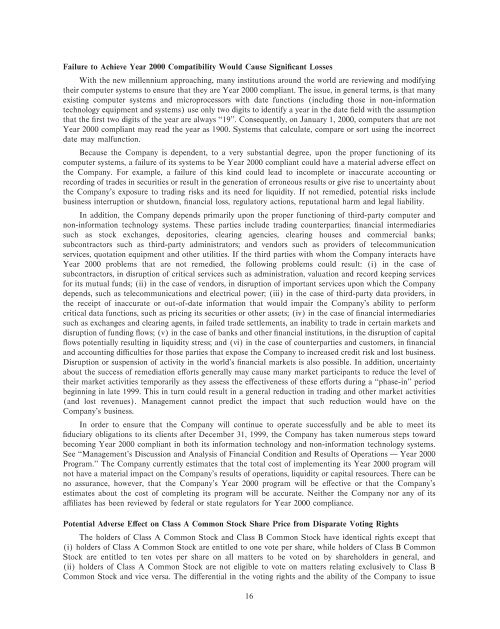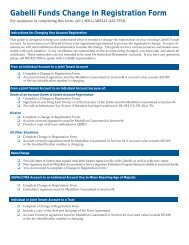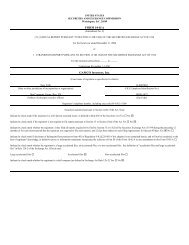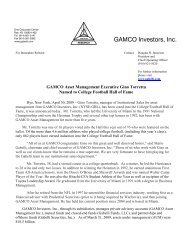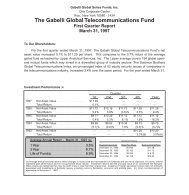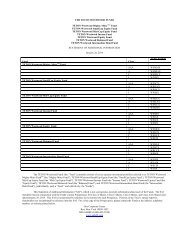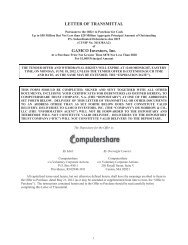Original GBL Prospectus - Gabelli
Original GBL Prospectus - Gabelli
Original GBL Prospectus - Gabelli
You also want an ePaper? Increase the reach of your titles
YUMPU automatically turns print PDFs into web optimized ePapers that Google loves.
Failure to Achieve Year 2000 Compatibility Would Cause SigniÑcant Losses<br />
With the new millennium approaching, many institutions around the world are reviewing and modifying<br />
their computer systems to ensure that they are Year 2000 compliant. The issue, in general terms, is that many<br />
existing computer systems and microprocessors with date functions (including those in non-information<br />
technology equipment and systems) use only two digits to identify a year in the date Ñeld with the assumption<br />
that the Ñrst two digits of the year are always ""19''. Consequently, on January 1, 2000, computers that are not<br />
Year 2000 compliant may read the year as 1900. Systems that calculate, compare or sort using the incorrect<br />
date may malfunction.<br />
Because the Company is dependent, to a very substantial degree, upon the proper functioning of its<br />
computer systems, a failure of its systems to be Year 2000 compliant could have a material adverse eÅect on<br />
the Company. For example, a failure of this kind could lead to incomplete or inaccurate accounting or<br />
recording of trades in securities or result in the generation of erroneous results or give rise to uncertainty about<br />
the Company's exposure to trading risks and its need for liquidity. If not remedied, potential risks include<br />
business interruption or shutdown, Ñnancial loss, regulatory actions, reputational harm and legal liability.<br />
In addition, the Company depends primarily upon the proper functioning of third-party computer and<br />
non-information technology systems. These parties include trading counterparties; Ñnancial intermediaries<br />
such as stock exchanges, depositories, clearing agencies, clearing houses and commercial banks;<br />
subcontractors such as third-party administrators; and vendors such as providers of telecommunication<br />
services, quotation equipment and other utilities. If the third parties with whom the Company interacts have<br />
Year 2000 problems that are not remedied, the following problems could result: (i) in the case of<br />
subcontractors, in disruption of critical services such as administration, valuation and record keeping services<br />
for its mutual funds; (ii) in the case of vendors, in disruption of important services upon which the Company<br />
depends, such as telecommunications and electrical power; (iii) in the case of third-party data providers, in<br />
the receipt of inaccurate or out-of-date information that would impair the Company's ability to perform<br />
critical data functions, such as pricing its securities or other assets; (iv) in the case of Ñnancial intermediaries<br />
such as exchanges and clearing agents, in failed trade settlements, an inability to trade in certain markets and<br />
disruption of funding Öows; (v) in the case of banks and other Ñnancial institutions, in the disruption of capital<br />
Öows potentially resulting in liquidity stress; and (vi) in the case of counterparties and customers, in Ñnancial<br />
and accounting diÇculties for those parties that expose the Company to increased credit risk and lost business.<br />
Disruption or suspension of activity in the world's Ñnancial markets is also possible. In addition, uncertainty<br />
about the success of remediation eÅorts generally may cause many market participants to reduce the level of<br />
their market activities temporarily as they assess the eÅectiveness of these eÅorts during a ""phase-in'' period<br />
beginning in late 1999. This in turn could result in a general reduction in trading and other market activities<br />
(and lost revenues). Management cannot predict the impact that such reduction would have on the<br />
Company's business.<br />
In order to ensure that the Company will continue to operate successfully and be able to meet its<br />
Ñduciary obligations to its clients after December 31, 1999, the Company has taken numerous steps toward<br />
becoming Year 2000 compliant in both its information technology and non-information technology systems.<br />
See ""Management's Discussion and Analysis of Financial Condition and Results of Operations Ì Year 2000<br />
Program.'' The Company currently estimates that the total cost of implementing its Year 2000 program will<br />
not have a material impact on the Company's results of operations, liquidity or capital resources. There can be<br />
no assurance, however, that the Company's Year 2000 program will be eÅective or that the Company's<br />
estimates about the cost of completing its program will be accurate. Neither the Company nor any of its<br />
aÇliates has been reviewed by federal or state regulators for Year 2000 compliance.<br />
Potential Adverse EÅect on Class A Common Stock Share Price from Disparate Voting Rights<br />
The holders of Class A Common Stock and Class B Common Stock have identical rights except that<br />
(i) holders of Class A Common Stock are entitled to one vote per share, while holders of Class B Common<br />
Stock are entitled to ten votes per share on all matters to be voted on by shareholders in general, and<br />
(ii) holders of Class A Common Stock are not eligible to vote on matters relating exclusively to Class B<br />
Common Stock and vice versa. The diÅerential in the voting rights and the ability of the Company to issue<br />
16


